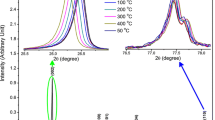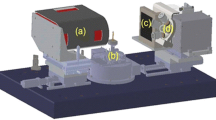Abstract
With the aim of developing neutron moderator and neutron reflector materials for fluoride-salt-cooled high-temperature reactors (FHRs), static infiltration tests were performed on graphite materials in molten 2LiF–BeF2 (FLiBe) salt, which is a potential primary coolant, at 700 °C and various pressures. The weight gain ratios of four grades (NBG-18, IG-110, NG-CT-10, and NG-CT-50) of graphite after infiltration were measured to determine their infiltration curves. The threshold pressure for FLiBe salt infiltration for the ultrafine-grained graphite (NG-CT-50) was greater than 600 kPa and much higher than those of the other three grades (medium-grained/fine-grained graphites), indicating that this graphite grade more probably resists salt infiltration in FHRs than other grades of graphite. However, if the threshold pressure is exceeded, it has the highest potential capacity for infiltrated salt over the pressures tested. The four grades were also characterized using mercury intrusion porosimetry. It was found that the infiltration curves of these two unwetting liquids were very similar. Scanning electron microscopy characterization showed that the FLiBe salt was distributed relatively uniformly in all four grades, indicating the presence of interconnected networks of open pores throughout the samples. X-ray diffraction patterns showed that infiltration test at high pressure led to an improved structural order and a decreased d-spacing in graphite.













Similar content being viewed by others
References
A Technology Roadmap for Generation IV Nuclear Energy Systems (2002) Generation IV International Forum, GIF-002-00
Serp J, Allibert M, Beneš O, Delpech S, Feynberg O, Ghetta V (2014) The molten salt reactor (MSR) in generation IV: overview and perspectives. Prog Nucl Energy 77:308–319. doi:10.1016/j.pnucene.2014.02.014
LeBlanc D (2010) Molten salt reactors: a new beginning for an old idea. Nucl Eng Des 240(6):1644–1656. doi:10.1016/j.nucengdes.2009.12.033
Williams DF, Clarno KT (2008) Evaluation of salt coolants for reactor applications. Nucl Technol 163:330–343
Khokhlov V, Ignatiev V, Afonichkin V (2009) Evaluating physical properties of molten salt reactor fluoride mixtures. J Fluor Chem 130(1):30–37. doi:10.1016/j.jfluchem.2008.07.018
Delpech S, Cabet C, Slim C, Picard G (2010) Molten fluorides for nuclear applications. Mater Today 13(12):34–41. doi:10.1016/S1369-7021(10)70222-4
Briggs RB (1961) Molten-salt reactor program progress report Oak Ridge National Laboratory, ORNL-3122
MacPherson HG (1959) Molten-salt reactor project: quarterly progress report. Oak Ridge National Laboratory, ORNL-2723
He Z, Gao L, Wang X, Zhang B, Qi W, Song J, He X, Zhang C, Tang H, Xia H, Zhou X (2014) Improvement of stacking order in graphite by molten fluoride salt infiltration. Carbon 72:304–311. doi:10.1016/j.carbon.2014.02.010
Kasten PR, Bettis ES, Cook WH, Eatherly WP, Holmes DK, Kedl RJ, Kennedy CR, Kirslis SS, McCoy HE, Perry AM, Robertson RC, Scott D, Strehlow RA (1969) Graphite behavior and its effects on MSBR performance. Nucl Eng Des 9(2):157–195. doi:10.1016/0029-5493(69)90057-0
Calderon NR, Voytovych R, Narciso J, Eustathopoulos N (2010) Pressureless infiltration versus wetting in AlSi/graphite system. J Mater Sci 45(16):4345–4350. doi:10.1007/s10853-010-4358-y
Rodriguez A, Sanchez SA, Narciso J, Louis E, Rodriguez-Reinoso F (2005) Pressure infiltration of Al–Si alloys into compacts made of carbon particles. J Mater Sci 40(9–10):2519–2523. doi:10.1007/s10853-005-1985-9
Yang J, Chung DDL (1989) Casting particulate and fibrous metal matrix composites by vacuum infiltration of a liquid metal under an inert gas pressure. J Mater Sci 24(10):3605–3612. doi:10.1007/BF02385746
Alonso A, Pamies A, Narciso J, Garcia-Cordovilla C, Louis E (1993) Evaluation of the wettability of liquid aluminum with ceramic particulates (SiC, TiC, AI2O3) by means of pressure infiltration. Metall Trans A 24(6):1423–1432. doi:10.1007/BF02668210
Garcia-Cordovilla C, Louis E, Narciso J (1999) Pressure infiltration of packed ceramic particulates by liquid metals. Acta Mater 47(18):4461–4479. doi:10.1016/S1359-6454(99)00318-3
Briggs RB (1962) Molten-salt reactor program: semiannual progress report. Oak Ridge National Laboratory, ORNL-3282
Flanagan GF, Holcomb DE, Cetiner SM (2012) FHR generic design criteria. Oak Ridge National Laboratory, ORNL/TM-2012/226
Allen T, Ball S, Blandford E, Downar T, Flanagan G, Forsberg C (2013) Fluoride-salt-cooled, high-temperature reactor (FHR) subsystems definition, functional requirement definition, and licensing basis event (LBE) identification white paper. Integrated research project workshop, UCBTH-12-001
El-Genk MS, Tournier JMP (2012) Comparison of oxidation model predictions with gasification data of IG-110, IG-430 and NBG-25 nuclear graphite. J Nucl Mater 420(1):141–158. doi:10.1016/j.jnucmat.2011.09.027
Ingersoll DT, Parma EJ, Forsberg CW, Renier JP (2012) Core physics characteristics and issues for the advanced high-temperature reactor (AHTR). Oak Ridge National Laboratory
Briggs RB (1964) Molten-salt reactor program: semiannual progress report. Oak Ridge National Laboratory, ORNL-3626
Sheil RJ, Evans RB, Watson GM (1959) Molten salt-graphite compatibility test. Results of physical and chemical measurements. Oak Ridge National Laboratory, ORNL-59-8-133
Preliminary Fluoride Salt-Cooled High Temperature Reactor (FHR) Materials, Fuels and Components White Paper (2012) Integrated research project (IRP) workshop 3, UCBTH-12-003
Molina JM, Rodriguez-Guerrero A, Bahraini M, Weber L, Narciso J, Rodriguez-Reinoso F, Louis E, Mortensen A (2007) Infiltration of graphite preforms with Al–Si eutectic alloy and mercury. Scripta Mater 56(11):991–994. doi:10.1016/j.scriptamat.2007.01.042
He Z, Gao L, Qi W, Zhang B, Wang X, Song J, He X, Zhang C, Tang H, Rolmes H, Xia H, Zhou X (2015) Molten FLiNaK salt infiltration into degassed nuclear graphite under inert gas pressure. Carbon 84:511–518. doi:10.1016/j.carbon.2014.12.044
Kane J, Karthik C, Butt DP, Windes WE, Ubic R (2011) Microstructural characterization and pore structure analysis of nuclear graphite. J Nucl Mater 415(2):189–197. doi:10.1016/j.jnucmat.2011.05.053
Sure J, Shankar AR, Ramya S, Mallika C, Mudali UK (2014) Corrosion behavior of carbon materials exposed to molten lithium chloride–potassium chloride salt. Carbon 67:643–655. doi:10.1016/j.carbon.2013.10.040
Willis KL, Abell AB, Lange DA (1998) Image-based characterization of cement pore structure using wood’s metal intrusion. Cem Concr Res 28(12):1695–1705. doi:10.1016/S0008-8846(98)00159-8
Huang WH, Tsai SC, Yang CW, Kai JJ (2014) The relationship between microstructure and oxidation effects of selected IG-and NBG-grade nuclear graphites. J Nucl Mater 454(1):149–158. doi:10.1016/j.jnucmat.2014.07.052
Zheng G, Xu P, Sridharan K, Allen T (2014) Characterization of structural defects in nuclear graphite IG-110 and NBG-18. J Nucl Mater 446(1):193–199. doi:10.1016/j.jnucmat.2013.12.013
Burns JH, Gordon EK (1966) Refinement of the crystal structure of Li2BeF4. Acta Crystallogr A 20(1):135–138. doi:10.1107/S0365110X66000240
Acknowledgements
This work is supported by the strategic priority research program of Thorium-based Molten-salt Reactor (TMSR) (Grant No. XDA02040100) and National Natural Science Foundation of China (Nos. 11305240 and 21406257).
Author information
Authors and Affiliations
Corresponding authors
Rights and permissions
About this article
Cite this article
Tang, H., Qi, W., He, Z. et al. Infiltration of graphite by molten 2LiF–BeF2 salt. J Mater Sci 52, 11346–11359 (2017). https://doi.org/10.1007/s10853-017-1310-4
Received:
Accepted:
Published:
Issue Date:
DOI: https://doi.org/10.1007/s10853-017-1310-4




